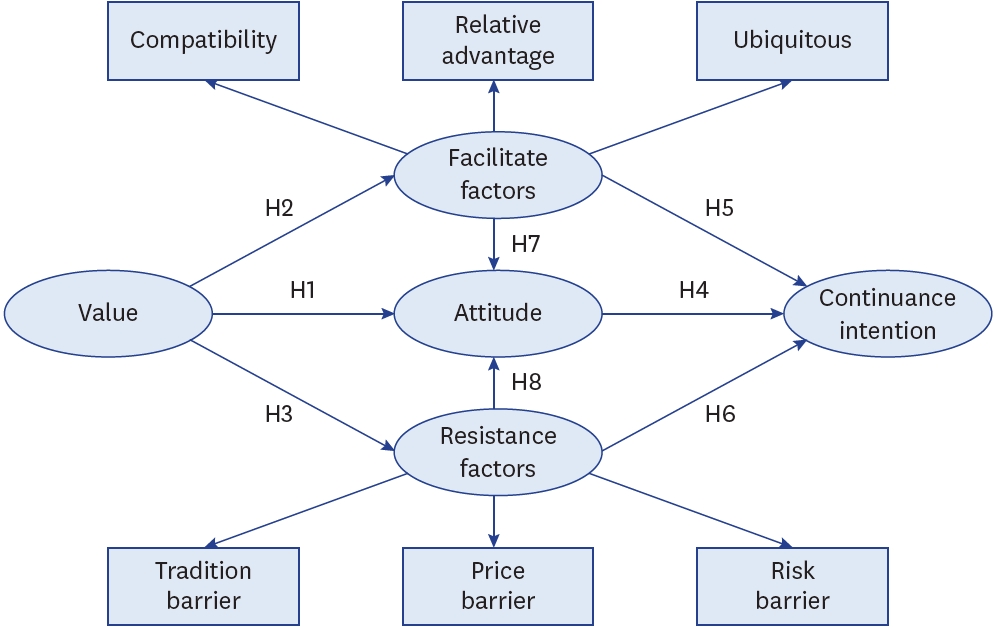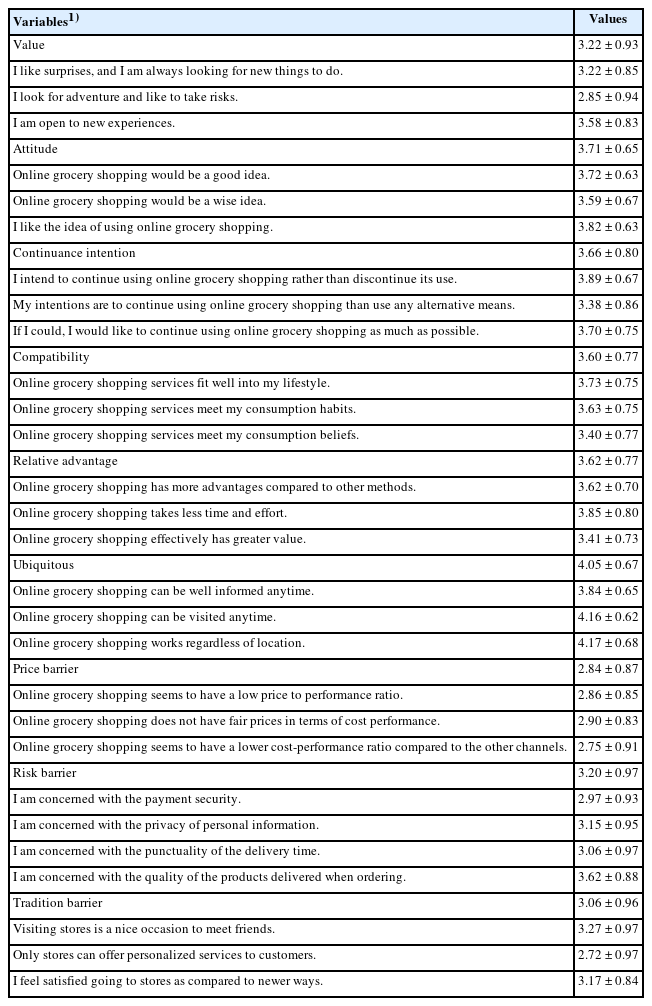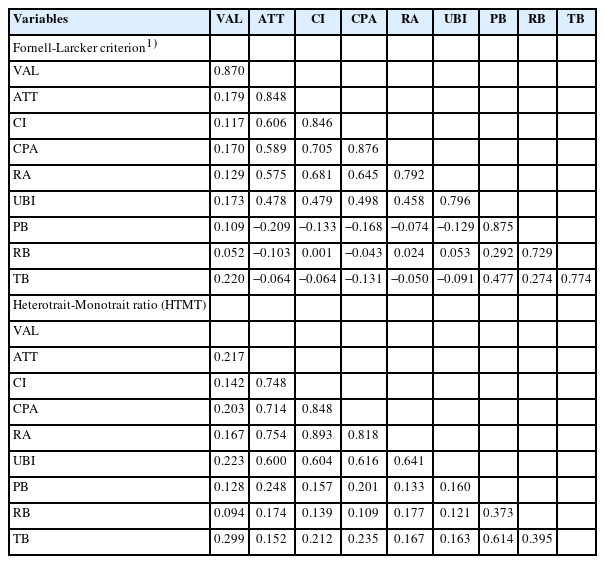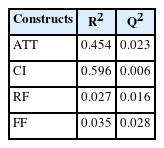Factors influencing consumers’ continuance intention in online grocery shopping: a cross-sectional study using application behavior reasoning theory
Article information
Abstract
Objectives
Online grocery shopping has gained traction with the digital transformation of retail. This study constructs a behavioral model combining values, attitudes, and reasons for behavior—specifically, facilitators and resistance—to provide a more novel discussion and further understand the relative influences of the various factors affecting continuance intention in online grocery shopping.
Methods
Data were collected through an online questionnaire from consumers who had engaged in online grocery shopping during the past month in Seoul, Korea. All collected data were analyzed using descriptive analysis, and model validation was performed using partial least squares structural equation modeling.
Results
Continuance intention is primarily driven by facilitative factors (compatibility, relative advantage, and ubiquity). Attitude can also positively influence continuance intention. Although resistance factors (price, tradition, and risk) do not significantly affect continuance intention, they negatively affect attitude. Values significantly influence consumers’ reasoning processes but not their attitude.
Conclusions
These findings explain the key influences on consumers’ online grocery shopping behavior in Seoul and provide additional discussion and literature on consumer behavior and market management. To expand the online grocery market, consumers should be made aware of the potential benefits of the online channel; the barriers they encounter should be reduced. This will help sustain online grocery shopping behavior. Furthermore, its positive impact on attitude will further strengthen consumers’ continuance intention.
INTRODUCTION
The domestic online grocery market is rapidly developing, with online grocery shopping transactions reaching 36 trillion won in 2022, showing continued growth [1,2]. Moreover, changes in the external environment have influenced consumers to accept new purchasing experiences and habits [3,4]. Infectious diseases such as coronavirus disease 2019 (COVID-19) have greatly impacted consumer behavior, and even without restrictions on going out, most consumers still wish to maintain their online grocery shopping behavior [5]. Consumer demand for online grocery shopping continues to increase, but the domestic online grocery market penetration rate is only 25%, which is relatively low compared with the 45% rate in other industries [6]. Accordingly, identifying the factors that influence consumers to maintain their online grocery shopping behavior is expected to help expand the future of the online grocery market.
In the previous study, the role of online grocery shopping was defined and the market was analyzed on the basis of user type [7]. According to Kim & Kim [8], Korean consumers choose online grocery shopping for delivery services, product quality, and low prices. Kim [9] showed that Korean consumers who use mobile shopping malls are primarily influenced by their practicality. However, most studies have focused on the acceptance behavior stage, with almost no discussion on the continuous usage stage after purchase. Lim et al. [10] examined the repurchase intention of online fresh food consumers and found that visit frequency moderates consumer behavior. Some researchers also believe that as the impact of COVID-19 gradually decreases, changes in consumer behavior or cognition are likely. Furthermore, in addition to the impact on consumer behavior preferences or habits, consumers' perceptions of online grocery shopping behavior may also change [11,12].
Various factors influence consumers’ choice of online grocery shopping channels. In particular, technology can provide more benefits in grocery shopping, but competitors can easily imitate these technological aspects [13]. Therefore, among the various influencing factors, the impact of consumer cognition on behavioral decisions should be examined [14]. Values are a very stable personal characteristic that is an important antecedent factor in determining purchasing behavior and inducing preferences [14]. Hofstede’s value system has been applied in various fields of research, but its limitation is that it emphasizes cultural value differences due to differences between countries. Therefore, it may have low explanatory power for individual consumer behaviors [15]. Accordingly, Schwartz [16] explained individual values in four different dimensions—conservation, openness to change, self-enhancement, and self-transcendence— to identify the detailed aspects of purchasing behavior according to differences due to consumers’ intrinsic characteristics. Among them, openness to change was explained as consumers pursuing their own emotions and tastes in an unknown environment, and values related to openness to change have been considered to have explanatory power when measuring consumer behavior in online shopping [17,18].
Online grocery shopping behavior can be seen as a process in which consumers continuously accept innovation [19], and the adoption or resistance to this behavior may depend on consumers’ perceptions of the attributes of the innovation [20]. In research related to online shopping behavior, the characteristics of innovation are explained as reasons for behaviors occurring and spreading [21-23]. Additionally, consumers’ perceptions that innovationrelated aspects can bring more benefits to online grocery shopping can help with actual purchasing behavior and repurchase decisions [24]. Kleijnen et al. [25] measured resistance to innovation in both functional and psychological dimensions, stating that innovation requires consumers to break existing values or habits; they found that resistance factors can explain the discontinuation or abandonment of purchasing behavior. Claudy et al. [26] attempted to approach innovation and resistance factors in an integrated manner and conducted research to verify the validity of consumers' behavioral intentions. However, the applicability and role of these factors in online grocery shopping require further discussion. Therefore, this study aims to identify the factors that influence consumers’ online grocery shopping behavior. Most previous studies have focused on facilitating or positive factors in purchasing behavior but have rarely addressed resistance factors [27]. However, as online shopping behavior becomes more common, maintaining purchasing behavior has been shown to be difficult owing to the limited understanding of factors that inhibit consumer behavior and of acceptance barriers [28]. To identify the factors influencing continuous purchasing behavior in online grocery shopping, this study analyzes consumer purchasing behavior using behavioral reasoning theory. Behavioral reasoning theory is an extension of the theory of planned behavior and can explain a wide range of purchasing behaviors [26]. Value extension can help us understand consumers' attitude and information processing, such as reasoning [29]. The facilitating and resistance factors of behavior do not necessarily have to be quantitatively the same or opposite, and the proposed model can identify the relative influences of different factors within a single theoretical model [14,30]. The extended theoretical structure of behavioral reasoning theory has been verified in research on innovation resistance diffusion [26], online shopping [31], and food-related fields [32,33]. It provides researchers with various cognitive perspectives to understand consumer intentions and behavior. Therefore, it can help identify the factors influencing online grocery shopping continuance behavior according to domestic consumer values, attitude related to online grocery shopping, and facilitating and resistance factors. Furthermore, it can provide reference materials or empirical evidence useful to managers in the food and restaurant industry to develop better plans.
METHODS
Ethics statement
This study was approved by the Institutional Review Board of Korea National University of Transport (KNUT IRB 2023-07). All participants were required to read a description of the content and purpose of the study prior to the start of the survey and to provide an online consent form.
1. Subject and survey period
A survey was conducted from November to December 2023 by posting an online recruitment notice targeting consumers residing in Seoul who frequently purchase groceries online [1]. The survey was conducted on 300 consumers aged 20 years or older who had experience using online channels to purchase groceries within the last month through quota sampling. A total of 293 responses, excluding insincere or missing data, were collected for the final data analysis.
2. Survey contents
This study aimed to discuss how consumers’ values, attitudes, facilitating factors, and resistance factors influence online grocery shopping behavior. We established the following eight hypotheses for this purpose (Figure 1). Consumer values influence attitude (H1), facilitating factors (H2), and resistance factors (H3) as antecedents of overall shopping behavior decision-making [17,18]. Attitude is a major predictor of purchase decisions or continuous behavior in consumer behavior [34-36], thus a positive attitude may be one of the main causes for maintaining continuous purchasing behavior (H4). A sufficient rational basis for consumer behavior can directly influence continuous intention without complex decision-making processes [37,38]. In this case, facilitating factors positively influence continuous intention (H5), and resistance factors negatively influence it (H6). Additionally, facilitating factors positively influence attitude (H7) and resistance factors negatively influence attitude (H8).
The questionnaire comprised three main parts to verify the proposed model and hypotheses. First, to measure all the observed items of the model, the items were reconstructed after reviewing the rationality and accuracy of the measurements based on previous studies. Along with Ashfaq et al.’s [38] openness to change value scale and attitude [14], continuous intention [39], relative advantage, ubiquity [31], and compatibility [40] related to facilitating factors, price barriers [41], and tradition barriers [30] related to resistance factors, risk barriers were reconstructed based on the four items proposed by Driediger & Bhatiasevi [7]. All items were measured using a 5-point Likert scale. The second part of the questionnaire consisted of the demographic characteristics of consumers to understand the general characteristics of the survey target. The last part was related to the actual state of online grocery shopping.
3. Data analysis
The data collected in this study were analyzed using SPSS Statistics 28 (IBM Corp., Armonk, NY, USA) for the descriptive statistical analyses. SmartPLS 4 (GmbH SmartPLS, Bönningstedt, Germany) was used to perform model verification and statistical analysis using partial least squares structural equation modeling (PLS-SEM). PLS-SEM can provide researchers with stable results when exploring theories and addressing complex problems. In verifying the measurement model, reliability was explained using Cronbach’s α and composite reliability (CR). Convergent validity was verified using the average variance extracted (AVE), and discriminant validity was verified using the Fornell-Larcker criterion and Heterotrait-Monotrait ratio (HTMT). The evaluation criteria for these methods used the threshold values proposed by Hair et al. [42]. Based on this, the path hypotheses of the structural model were verified, and the predictability of the model was evaluated using R2, Q2, and f2.
RESULTS
1. Sample characteristics
The characteristics of the sample are listed in Table 1. This study included 146 men (49.8%) and 147 women (50.2%). Sixty respondents were in their 50s (20.5%), 59 in their 40s and more than 60s (20.1%), and 58 in their 30s (19.8%), indicating an even distribution. Regarding educational level, 196 (66.9%) were university graduates, 52 (17.7%) were high school graduates, and 44 (15.0%) had a master’s degree or higher. The largest occupational group was general office workers at 131 (44.7%), followed by housewives at 44 (15.0%), and the self-employed at 26 (8.9%). The highest monthly household income was 6 million won or more (n = 107, 36.5%), followed by 4–5 million won (n = 48, 16.4%), and 2–3 million won (n = 44, 15.0%).
2. Factors influencing online grocery shopping
Table 2 presents the results of the descriptive statistical analysis of the factors influencing online grocery shopping. Overall, consumers had a relatively high perception of the ubiquity of online grocery shopping (4.05 ± 0.67), while the perception of price barriers was low (2.84 ± 0.87), likely due to the relatively high monthly household income of the respondents. Looking at consumers’ perceptions of each item, “Online grocery shopping works regardless of location” (4.17 ± 0.68), “Online grocery shopping can be visited anytime” (4.16 ± 0.62), and “I intend to continue using online grocery shopping rather than discontinue its use” (3.89 ± 0.67) were rated highly. However, perceptions of “Only stores can offer personalized services to customers” (2.72 ± 0.97) and “Online grocery shopping seems to have a lower cost-performance ratio compared to the other channels.” (2.75 ± 0.91) were low.
3. Reliability and validity
The results of analyzing the reliability and validity of the measurement model using the PLS algorithm showed that Cronbach’s α and CR values were above 0.6, demonstrating suitability (Table 3). For validity, the AVE was used to evaluate whether the observed items accurately explained the factors. The AVE value of the risk barrier (0.532) was the lowest but higher than the minimum threshold proposed by Hair et al. [42], verifying the reliability and validity of all factors.
Discriminant validity explains the degree to which latent variables can be distinguished, and this study evaluated it using the results of the Fornell-Larcker criterion and HTMT (Table 4). To verify discriminant validity, the Fornell-Larcker criterion requires that the square root of AVE on the diagonal be larger than the correlation coefficients in the other matrices. In this study, the maximum correlation value was 0.705, and the minimum square root of the AVE was 0.729, verifying discriminant validity. In addition, HTMT is a more stringent method that complements the Fornell-Larcker criterion verification results. Most of the HTMT values for the factors were below 0.85, and the HTMT values for relative advantage and continuous intention were below 0.9, satisfying the HTMT threshold proposed by Henseler et al. [43] and verifying discriminant validity.
4. Structural model path verification
The path hypotheses were verified based on the measurement model (Table 5). The significance of the path relationships was verified using the bootstrapping method with 5,000 iterations of resampling. First, the influence of values on attitude was not statistically significant, rejecting H1 (β = 0.079, t = 1.479). However, facilitating (H2: β = 0.188, t = 3.127) and resistance (H3: β = 0.166, t = 2.623) factors were found to be influenced by consumer values. Second, the continuous intention of online grocery shopping was most influenced by facilitate factors (H5: β = 0.639, t = 12.393) constructed by relative advantage, ubiquity, and compatibility, followed by attitude (H4: β = 0.186, t = 3.099). By contrast, the resistance factors of online grocery shopping measured in the study did not significantly influence continuous intention, rejecting H6 (β = 0.015, t = 0.402). Finally, facilitate factors positively influenced consumers’ attitudes toward online grocery shopping (H7: β = 0.634, t = 14.051), whereas resistance factors had a statistically significant negative influence on attitude (H8: β = −0.112, t = 2.422). In addition, the f2 evaluation results showed an effect greater than 0.002 for each verified path (Figure 2).

Online grocery shopping mode path coefficients.
Path coefficients significant *P < 0.05, **P < 0.01, ***P < 0.001.
To further evaluate the predictive ability of the model, the R2 and Q2 results for the internal latent variables are presented in Table 6. The continuous intention model in this study showed an explanatory power of 59.6% for the variance, whereas the attitude toward online grocery shopping was 45.4%. Together with the Q2 results showing values greater than 0, it can be judged that the model proposed in this study has predictive explanatory power and predictive relevance through behavioral reasoning theory and facilitates and resists factors of innovation.
DISCUSSION
As consumers’ interest in purchasing groceries through online channels gradually increases, they perceive higher uncertainty when purchasing groceries online than when purchasing other products, making the decision-making process for purchasing behavior more difficult. Additionally, for consumer behavior, the success of e-commerce depends more on continuous usage than on the initial purchase decision [44]. Therefore, this study aimed to identify various factors influencing domestic consumers’ continuous online grocery shopping behavior.
First, values as a stable personal characteristic played a role in driving online grocery shopping behavior related to openness to change in this study [45]. This is consistent with the hypotheses of the behavioral reasoning theory model in this study, showing that continuous online grocery shopping is influenced by individual consumer values [14]. However, this study found that values did not influence attitude, suggesting that consumers may have a more complex value system when purchasing groceries online.
Second, attitude was verified as an important predictor of continuous intention in this study, similar to the study by Zheng et al. [46] on American consumers, where attitude, as an overall evaluation of behavior, was found to be a key prerequisite for continuous intention to purchase food online. Westaby [14] stated that behavioral intentions can be determined by various psychological paths, and verified the moderating effect of attitude.
Furthermore, Wood [47] and Bavel et al. [48] highlighted that the reason for consumer behavior is to maintain self-worth and needs, and that the sense of behavioral and psychological coherence remains in play after the behavior occurs and can be used to support, distort, or maintain subsequent behaviors. In the model proposed in this study, when consumers had sufficient reasons for online grocery shopping, it brought about behavioral and psychological balance. Therefore, facilitating or resistance factors may directly influence consumer decision-making or continuous intention [14]. This can explain why consumers may show a positive attitude toward the online grocery market, but not increase their actual shopping behavior.
Third, the facilitating factors had the strongest explanatory power for continuous intention and attitude, with compatibility being one of the most important facilitating factor. Compatibility refers to the degree to which a purchase decision aligns with the consumer’s lifestyle, values, past experiences, and needs. Similar to Lim et al. [49], this study found that when online grocery shopping meets consumer needs, it is more likely to lead to a positive attitude. However, although price is the biggest barrier for consumers in online grocery shopping, even price-sensitive consumers do not directly influence continuous intentions through resistance factors. In other words, when consumers have a positive attitude toward online grocery shopping, additional costs or other barriers do not necessarily lead to discontinued purchasing.
Online channels have brought new opportunities to the food market. This study provides various theoretical perspectives for understanding consumer behavior. Unlike most studies that have adopted the theory of planned behavior, behavioral reasoning theory provides a deeper explanation of online grocery shopping behavior. The gap between attitude and continued intention can be explained by extending consumer values, facilitating factors, and resistance factors. Additionally, while some researchers have questioned whether behavioral reasoning theory could explain consumers’ continuous intention [38], the model proposed in this study explained more than half of the variance in continuous intention, providing empirical evidence for further extending the theory’s scope of application. Thus, managers in food and restaurant markets should maximize consumers’ understanding of the potential benefits of online channels. Providing services more suitable for consumer situations can have a more positive impact on maintaining online grocery shopping behavior. Managers should also minimize the barriers faced by consumers because the prolonged accumulation of such inhibitions could lower their overall evaluation of their behavior. Kim & Kim [50] believed that subscription services could be a possible solution, providing a stable user base for the platform while offering consumers more opportunities for benefits.
This study has some limitations. First, we only collected data from consumers in the Seoul area, and further research and comparisons with other regions of Korea should be done in the future. Second, as behavioral reasoning is situation-based and online grocery shopping increases further, future studies could apply more comprehensive research methods, such as investigating the reasons for continued consumer behavior through qualitative methods such as consumer interviews.
CONCLUSION
This study provides new discussion points for future research on online grocery shopping behavior. In conclusion, when deciding whether to continue purchasing groceries online, consumers mainly rely on whether the groceries meet their personal needs. Additionally, even when there were resistance factors, consumers who showed a positive attitude toward online grocery shopping did not discontinue their continuous purchasing behavior. Therefore, managers in the food and restaurant markets need to focus more on factors related to consumers’ online grocery shopping, such as compatibility, relative advantage, and ubiquity. These factors not only positively influence attitude toward online grocery shopping but also provide direct and strong purchasing motivations for continuous behavior. The results of this study are expected to serve as empirical reference materials that can help managers and researchers in the food and restaurant markets gain a more practical understanding of how to maintain online grocery shopping behavior and extend future research on consumers’ continuous behavior in other food markets.
Notes
Conflict of Interest
There are no financial or other issues that might lead to conflict of interest.
Funding
This study did not receive any specific grants from funding agencies in the public, commercial, or non-profit sectors.
Data Availability
The participants of this study did not give written consent for their data to be shared publicly, so due to the sensitive nature of the research supporting data is not available.







